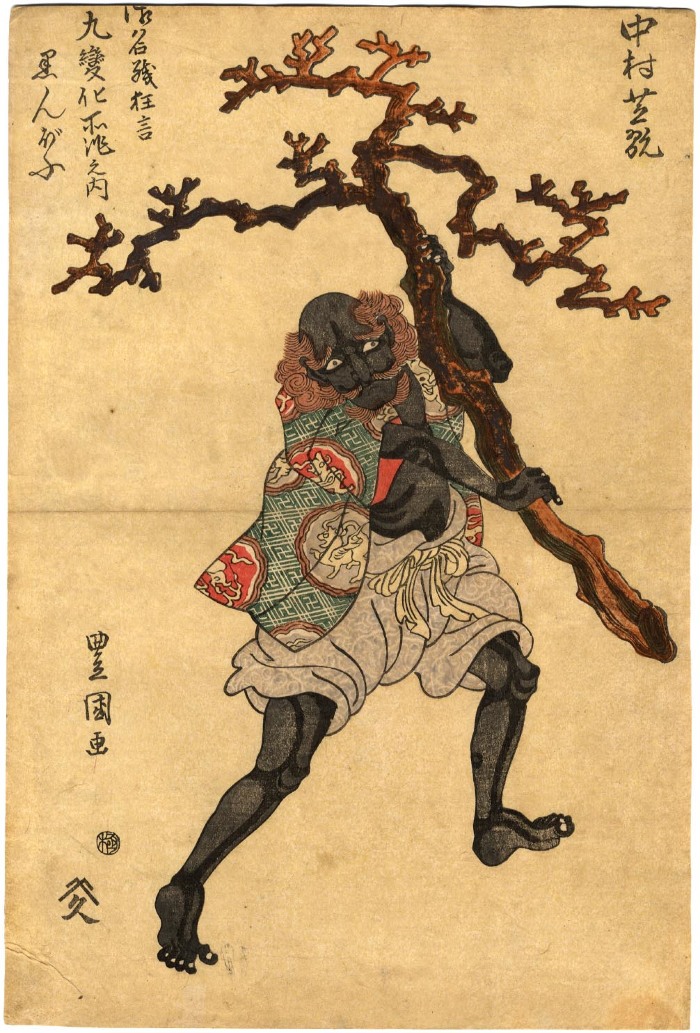Utagawa Toyokuni I (初代歌川豊国) (artist 1769 – 02/24/1825)
Nakamura Shikan I (中村芝翫) as a black man or kuronbō (黒んば) carrying a large piece of coral
09/09/1819
10 in x 14.5 in (Overall dimensions) Japanese woodblock print
Signed: Toyokuni ga
Publisher: Yamamotoya Heikichi
(Marks 595 - seal 04-007
Censor seal: kiwame
Waseda University
Lyon Collection - Yoshikuni of Nakamura Utaemon in the same role in 1825
Edo-Tokyo Museum
Tokyo Metropolitan Library -1819 Kunisada print of the same role and actor As we can see from this series this is most definitely from one of those spectacular quick quick-change performances which so totally wowed their audiences. A tour de force of theatricality for the actor who is capable of pulling it off.
****
There are two prints in the Lyon Collection of the same man acting under different stage names, several years apart, as the black man or kuronbō - first as Shikan I and later as Utamaro III. The kuronbō was only one stage persona is a set of quick change figures. For the other example go to #124.
****
One can only speculate how Shikan was received by the audience when he appeared as a South Seas native carrying a large piece of coral. Perhaps it was somewhat like the late 19th to early 20th century American crowds when performers in black face appeared in minstrel shows. A raucous time was had by all.
****
Kuronbō (黒ん坊) is generally used as a denigrating terms. At best it can describe 'darkies', but at its most vulgar it is tantamount to using the 'n' word in the United States. While the Japanese already held a dim view of dark skinned people their prejudices were reinforced by the biases of the Dutch who visited Nagasaki. In fact, while Dutch men could visited the prostitutes of that port, sexual contact with kuronbō was discouraged.
****
Note that when you are doing research on the term 'kuronbō' you might want to also look for it under the spelling k-u-r-o-m-b-ō, with or without the long 'o' at the end.
****
The Japanese and their attitudes toward blacks
As with all social issues, there are a multitude of opinions - often contradictory - that run through a society. Sometimes they are explicit and sometimes they are implicit. This is particularly true of the Japanese attitudes toward dark skinned people. For instance, Manami Matsuoka in her article 'Unveiling Race and Japanese Identity Through Kokusai Kekkon' from 2021 discusses the persistence of bigotry that runs through the culture, vis a vis, black men. In Gary P. Leupp's article from 1995, 'Images of black people in late mediaeval and early modern Japan 1543–1900', he said: "Thus black Africans, and other peoples with whom they were commonly conflated, were alternately honored, tolerated, and disparaged by the Japanese..." Leupp pointed out that Japanese attitudes toward Africans were often muddled by three factors: 1) the Japanese didn't participate in any way in the slave trade in any way; 2) black men who were brought to Japan were often viewed as underlings or even the slaves of white men; and 3) the dark nature of the Africans flesh tones were often associated with the skin color of many Asian Indians/Buddhists and those fo South Sea Islanders.
****
On March 28, 2006 Christie's sold an 1860 woodblock print by Sadahide (1807-1878/79). Their description reads: "Sangoju (Coral)/Kuronbo no e (Picture of [a man from] Colombo), from the series Yokohama shoka nimotsu no uchi (Products of a foreign merchant in Yokohama), 1860.3..." We have added a jpeg image of this print, but from the one in the collection of the Metropolitan Museum of Art. They entitle their copy as "Stick of Coral and a Portrait of South Sea Islander". The term 'Colombo', in our opinion, may be a reference to the capital of Ceylon, i.e., Sri Lanka, an island nation just south of India and not included in the islands of the South Seas. The pairing of an exotic looking man from Colombo with the equally exotic, but not unknown, 'stick of coral', may have been a natural link-up in the mind of Sadahide or his publisher or whoever might have commissioned this print.
****
Illustrated in color reproduction in Japanese Woodblock Prints: Artists, Publishers and Masterworks 1680-1900 by Andreas Marks, Tuttle Publishing, 2010, page 260.
actor prints (yakusha-e - 役者絵) (genre)
Nakamura Utaemon III (三代目中村歌右衛門) (actor)
Yamamotoya Heikichi (山本屋平吉) (publisher)
